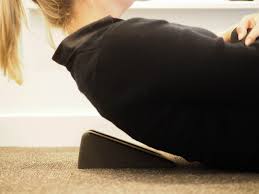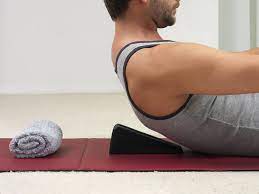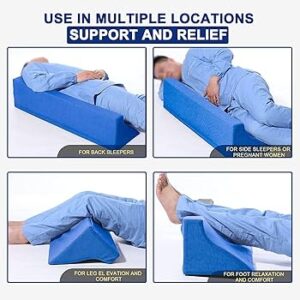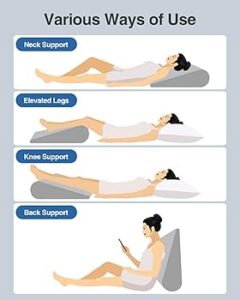

Maintaining proper cervical spine alignment is vital for spinal health, posture, and overall well-being.
Misalignment, whether due to poor posture, injuries, or degenerative conditions, can lead to chronic pain and impaired functionality.
One effective non-invasive method for addressing alignment issues involves the use of wedges.
These devices are designed to modify spinal posture and support corrective therapy.
This article explores how wedge placement impacts cervical spine alignment, backed by scientific evidence and practical guidelines.
Article Index
- Understanding Cervical Spine Alignment
- The Role of Wedges in Spinal Alignment
- Types of Wedges and Their Applications
- Clinical Evidence Supporting Wedge Use
- Practical Guidelines for Wedge Placement
- Potential Risks and Considerations
- Conclusion
Understanding Cervical Spine Alignment
The cervical spine is composed of seven vertebrae (C1-C7) and forms a natural inward curve called cervical lordosis.
This curvature is vital for maintaining the head’s balance, reducing the load on the cervical vertebrae, and evenly distributing mechanical stress across the spine.
When the natural curve is disrupted—either through straightening or reversal (kyphosis)—it can result in chronic neck pain, nerve compression, and restricted mobility.
As per a study published in The Journal of Spinal Disorders & Techniques, the loss of cervical lordosis significantly increases strain on spinal muscles and ligaments.
This additional strain accelerates wear and tear, leading to disc degeneration and herniation. Left uncorrected, these issues can contribute to progressive spinal instability and long-term complications.
Restoring cervical lordosis through targeted interventions, such as therapeutic exercises or wedge placement, is essential for alleviating pain, protecting spinal integrity, and preventing further degeneration.
The Role of Wedges in Spinal Alignment
Wedges are specialized therapeutic tools designed to improve cervical spine alignment by modifying the positioning of the vertebrae.
They are widely used in physical therapy and chiropractic care to promote the restoration of the cervical spine’s natural inward curve, known as cervical lordosis.
By supporting this curvature, wedges help reduce strain on the surrounding muscles, ligaments, and intervertebral discs, ultimately alleviating discomfort and preventing further spinal deterioration.
As per research published in Clinical Biomechanics (2023), the use of cervical wedges during corrective therapy has been shown to significantly improve posture by enhancing the biomechanical relationship between the vertebrae.
These devices are particularly effective in addressing forward head posture, a condition commonly caused by prolonged screen use, poor ergonomics, and sedentary lifestyles.
Forward head posture places excessive strain on the cervical spine, contributing to chronic pain and reduced mobility.
Cervical wedges, when properly positioned and consistently used, serve as a non-invasive and effective tool for realigning the cervical spine and promoting long-term spinal health.
Types of Wedges and Their Applications (and what they actually do for your neck)
There are 3 types of wedge pillows. Here is a quick look at each of these in brief:
Cervical Denneroll (the “precision-curve” block)
Think of the Denneroll as a shaped fulcrum that coaxes your neck back toward its natural C-curve using gentle, sustained extension.
Clinical trials adding cervical extension traction (via devices like the Denneroll) to exercise-based care have reported improvements in cervical lordosis, reductions in forward head posture, and better pain/disability scores, with benefits that can persist at follow-up.
Typical programs run several sessions per week for 8–10 weeks.
Mechanistically, the long-hold positioning likely remodels viscoelastic tissues and resets muscle tone around a healthier alignment.
Best used under clinician guidance, especially if you have neurological symptoms or a history of cervical surgery.
Neck Wedge Orthosis (the “steady support” foam)
The neck wedge is the minimalist cousin: a dense foam support that helps you practice gentle extension, open the chest, and breathe without shrugging your shoulders into your ears.
It isn’t meant to “remodel” curves as much as it is to reduce guarding and give your nervous system a calmer reference position.
It shines as part of a daily mobility routine—pair ten relaxed breaths with low-effort chin tucks or pec stretches.
Match the tool to the job: soft tissue tightness and desk fatigue respond well; acute trauma and instability do not.
Wedge Pillows (the “elevate and chill” option)
These triangular workhorses lift the head and upper thorax so you can rest without your neck complaining.
A smart elevation—often in the 20–30° ballpark—can ease post-operative discomfort, reduce swelling, and offload cervical musculature.
The biomechanics are simple: better head-neck alignment means less overnight strain and fewer “why is my neck a brick?” mornings.
Back sleepers tend to like a slightly higher wedge; side sleepers usually need a modest lift plus a supportive pillow to keep the neck neutral.
Too flat or too steep both backfire, so start conservative and tweak.
Quick Choosing Guide:
- Want measurable curve change and posture gains? Go Denneroll within a structured program.
- Want gentle positioning for recovery days? Reach for a neck wedge orthosis.
- Fighting night-time symptoms or post-op gripes? Try a wedge pillow with modest elevation.
Smart Setup Tips:
Ease in (3–5 minutes for the first few sessions), keep discomfort below “mild stretch,” and progress gradually. If you have osteoporosis that changed your spinal curvature, acute radiculopathy, dizziness, or recent surgery, clear your plan with a clinician first.
Clinical Evidence Supporting Wedge Use
Scientific studies have demonstrated the efficacy of wedges in improving cervical spine alignment.
- Improved Cervical Lordosis: According to research in The European Spine Journal (2022), therapeutic wedge placement led to significant improvements in cervical lordosis in patients with chronic neck pain. Over 12 weeks, patients using a cervical wedge showed a 20% reduction in pain scores and improved range of motion.
- Reduction in Forward Head Posture: A study in Journal of Manipulative and Physiological Therapeutics found that cervical wedges reduced forward head posture by an average of 12 degrees over a six-week treatment period. This postural correction resulted in decreased muscle tension and improved spinal biomechanics.
- Support in Post-Surgical Recovery: In patients recovering from cervical spine surgery, wedge pillows have been shown to provide optimal support, reducing post-operative strain. As per a study published in Orthopedic Research and Reviews (2021), patients using wedge pillows reported less discomfort and faster recovery compared to those using standard pillows.
Practical Guidelines for Wedge Placement
To maximize the benefits of wedges, proper placement and usage are essential.
- Professional Assessment: A comprehensive evaluation by a healthcare provider is necessary to identify alignment issues and determine the correct wedge type and placement.
- Targeted Placement: Position the wedge under the cervical spine’s midsection to encourage natural lordosis. The placement may vary based on individual anatomical needs.
- Gradual Introduction: Begin with short sessions (5–10 minutes) and gradually increase duration as the body adapts to the corrective posture.
- Regular Monitoring: Regular check-ins with a physical therapist or chiropractor ensure progress and allow for adjustments to the treatment plan.
Potential Risks and Considerations
While wedges are effective tools for correcting cervical spine alignment, improper use can lead to unintended consequences.
It is essential to understand the potential risks and follow professional guidance to maximize their benefits safely.
- Muscle Strain: Overuse or incorrect placement of wedges can put undue stress on cervical muscles, leading to pain or discomfort. This is especially true if the wedge forces the neck into an unnatural position or is used for prolonged periods without adjustment.
- Worsened Alignment: Using wedges without proper assessment may exacerbate pre-existing spinal issues, such as reversed curvature or structural deformities. This highlights the importance of individualizing wedge placement to address specific alignment needs.
- Contraindications: People with severe spinal instability, fractures, advanced degenerative diseases, or acute injuries should avoid wedge use unless explicitly approved by a specialist. Incorrect application could worsen these conditions.
As per a study in the Journal of Orthopedic Science, professional supervision is critical to ensure safe and effective use of wedges.
A trained healthcare provider can assess individual spinal conditions, recommend the right wedge type and placement, and monitor progress, minimizing risks while enhancing therapeutic outcomes.
Regular follow-ups are essential to ensure adjustments are made as needed for optimal results.
Conclusion
Wedge placement is a highly effective and non-invasive tool for correcting cervical spine alignment and alleviating discomfort caused by poor posture or misalignment.
Using wedge pillow at office is an ideal way to reduce bad neck posture.
These therapeutic devices promote the restoration of natural cervical lordosis, helping to reduce muscular strain, improve spinal biomechanics, and enhance overall spinal health.
By targeting specific vertebral segments, wedges encourage proper alignment, which can alleviate conditions like forward head posture and chronic neck pain.
Scientific studies, such as those published in the Journal of Physical Therapy Science, show that cervical wedges are effective in reducing forward head posture and improving spinal curvature over time.
They are often used in conjunction with chiropractic care, physical therapy, or home-based exercises as part of a comprehensive treatment plan.
When applied under professional supervision, wedges not only correct alignment but also prevent further degeneration by relieving pressure on the vertebrae and intervertebral discs.
For individuals struggling with neck pain or postural imbalances and are wondering how to fix the curve in your neck, wedges can provide long-term relief, enhance mobility, and significantly improve quality of life.
References:




